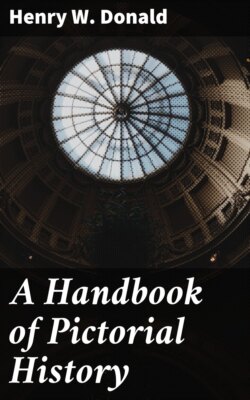Читать книгу A Handbook of Pictorial History - Henry W. Donald - Страница 22
На сайте Литреса книга снята с продажи.
THE BAYEUX TAPESTRY.
ОглавлениеTable of Contents
The Bayeux Tapestry is a valuable picture of the manners and costumes of the Normans and the English about the time of the Norman Conquest. It is traditionally recorded to have been worked by Queen Matilda (the wife of William the Conqueror) and the ladies of her Court, to commemorate the invasion and conquest of England by her husband.
There is no evidence to prove this, and consequently there is much doubt about it; but it is held on the best authority that though the Tapestry is a contemporary work, Queen Matilda had no part in its manufacture, since it was probably ordered for his cathedral by Bishop Odo (the half-brother of William I.), and made by Norman workers at Bayeux.
It is preserved in the Hotel-de-Ville at Bayeux, and consists of a long band of linen about 231 ft. long and 20 in. wide.
It is divided into 72 scenes or compartments, separated from one another by trees or buildings, worked in the material in a conventional manner. On it are represented 623 people, 202 horses and mules, 55 dogs, 505 other animals, 37 buildings, 41 ships and boats, and 49 trees, making a total of 1,512 objects. It has always been known as “tapestry,” but it is really an enormous piece of woolwork or embroidery, yet it has been known so long by the previous name that it will probably continue to bear it.
No attempt has been made to depict the figures in their natural colours, for we find horses coloured yellow, red, blue, and green, and perspective has been totally disregarded. But “if the drawing be rude, the composition is bold and spirited, and is always rendered with great truth of expression, which is, at times, exaggerated.”
The narrow border which runs along both the top and the bottom of the Tapestry (Pl. 19, Fig. 3) is for the greater part not connected with the thread of the story, and is decorated with animals, real and fabulous, and scenes of husbandry and the chase; but in some parts it contains allegorical allusions to the scenes depicted.
Over most of the scenes are worked Latin inscriptions in Roman capitals about an inch high, explaining the pictures. The reasons for supposing that, although not made by Matilda, it is nevertheless contemporary work, are:
(1) The accurate representation of the civil and military costumes of the eleventh century.
(2) The attempt to represent Edward the Confessor and William I. as they appeared on their seals.
(3) Certain words used in it suggest an English origin, but admit of the explanation that the dialect spoken in Bayeux was a mixture of Saxon and Norman.
(4) The prominence given to Odo and to less-known persons.
(5) The introduction of the local form of wine barrel and certain dialectic peculiarities of the district.
The Bayeux Tapestry is not mentioned in any historical document until 1476, when it appears among an inventory of the ornaments of the Cathedral of Bayeux.
In 1522 its safety was threatened by the Calvinists who pillaged the cathedral, but it was restored to the authorities and was used to decorate the nave on festive occasions.
It remained forgotten till 1724, when, a drawing having been made of it by an antiquarian, public interest was aroused in it, both in France and in our own country.
In order to preserve it, it was lined and strengthened, for it was used to decorate the nave for eight days at the time of St. John’s Day. It has passed through many vicissitudes, and once or twice it was nearly destroyed, but a number of the leading inhabitants of Bayeux formed themselves into a committee to protect it.
Napoleon I. went to see it, and was much impressed by it when it was exhibited in Paris. It was afterwards returned to Bayeux, where it was visited by Mr. Charles Stothard, a clever and accurate young artist, and at the request of the Society of Antiquaries of London he made drawings of it, the work occupying him for two years.
In 1842 the Municipal Council of Bayeux provided a permanent resting place for the Tapestry in the Hotel de Ville, where it is still exhibited under glass, and where it has been visited by artists and archæologists from every part of the world. During the Franco-German war it was taken down, sealed in a zinc cylinder, and hidden away till all danger was past.
In 1871 permission was given to the English Government to make a photographic reproduction of the Tapestry, and a copy of this full-sized reproduction, coloured after the original, is now preserved at South Kensington.
The Tapestry commences with a picture of Edward the Confessor, and continues with scenes illustrating Harold’s visit to Normandy; his capture and appearance before William; his taking the oath of allegiance to William; his return to England and to Edward the Confessor; the death of the latter; the crowning of Harold; the preparations made by William (building ships, assembling soldiers, collecting food and arms) for the invasion of England; the passage of the English Channel; the landing at Pevensey; the march to Hastings; the preparations for the fight; a long and spirited picture of the battle, illustrating various incidents in it and culminating in the death of Harold and the flight of the defeated English.
(The writer wishes to express his great obligation for the above to Mr. Frank R. Fowke’s very complete work on The Bayeux Tapestry. Geo. Bell and Sons.)
